In the beginning of a look around the EFL League One’s best performing under 23 players, this first week focuses on Wycombe Wanderers midfielder Nnamdi Ofoborah. On loan from EPL side Bournemouth, Ofoborah has been a key part of the side that went on to win promotion through the playoffs against Oxford United at Wembley earlier this month.
With promotion secured, Ofoborah’s future looks unclear as his parent side face relegation to the same tier. A possible loan back to the chair boys could be on the cards, but with his impressive performances, Eddie Howe may look to involve Ofoborah in the squad to bounce back which would come as a major blow to Gareth Ainsworth’s side.
In this tactical analysis/scout report, we will look closer at the how Ofobrah has excelled in Ainsworth’s side to get his shot at the Championship and how he fits into the tactics deployed at Wycombe.
The role Ofoborah plays
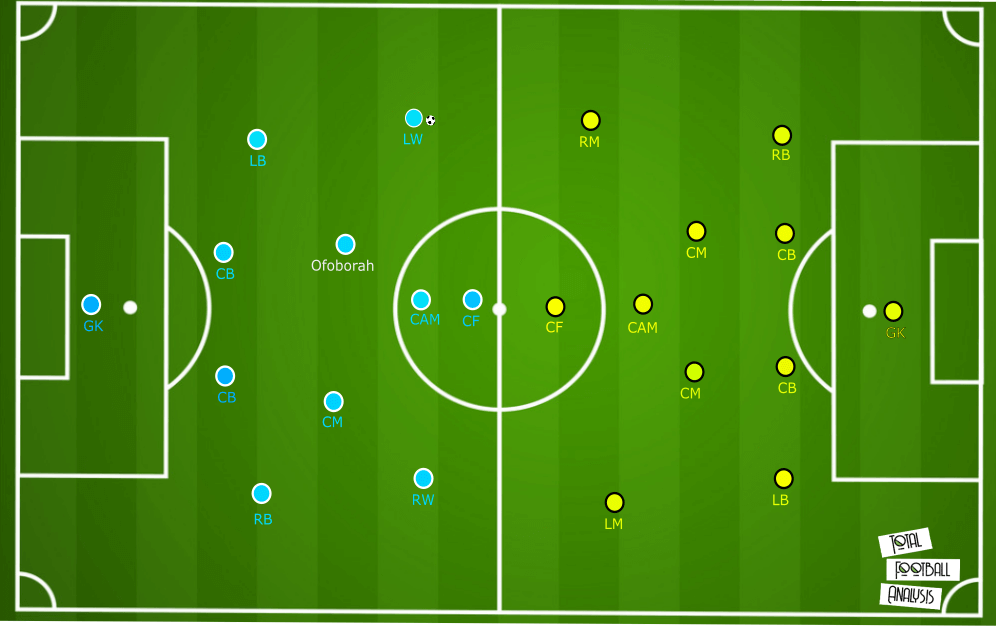
Ainsworth tends to set up his side in either a 4-4-1-1 or a 4-2-3-1, with Ofoborah operating as part of the two-man central midfield. Ofoborah looks to implement his physical power on the opponent on the left side of the two as shown in the example above from the second leg of the EFL League One Playoffs against former Manchester City midfielder Joey Barton’s Fleetwood Town.
In possession, Wycombe tend to look forward quickly, into space behind the opponent. With the ball in the opponents third, Wycombe look to maintain possession high by winning the second ball, with players in close proximity to maintain and build from a higher line. Ofoborah looks to play forward quickly himself, which can be seen at a detriment to his passing statistics. In 21 appearances in all competitions, Ofoborah shows 23.32 passes per 90 at an accuracy of 65.7%, ranking poorly against his league one counterparts. However, he shows that 10.76 of those passes are forward with 4.63 being progressive at an accuracy of 74.19%.
Out of possession, Wycombe drop into a mid-block. Ofoborah’s role within Ainsworth’s system is to be positioned to intercept centrally, sitting off his opponent and encourage risky passes into a congested central channel. Although as shown in their recent playoff final victory against Oxford United, Wycombe deployed more of a man to man setup to prevent effective midfield rotation. Wycombe are seen to press, based off the probability of winning the second ball as mentioned earlier. When the ball is lost in the final third, a counter-press is applied before regressing into their defensive block based off key opponents’ triggers playing forwards into the wide channels.
Ofoborah has certainly impressed with his application of Ainsworth’s concepts and in this tactical analysis, we will look at the aspects which have caught the attention this season.
Pressing
With 8.67 recoveries per 90, including 5.98 counter-pressing recoveries, Ofoborah is an important part of Wycombe’s structure to win back possession. These statistics are even more impressive when as shown in the graphic below, are the areas which Ofoborah displays this such concept.
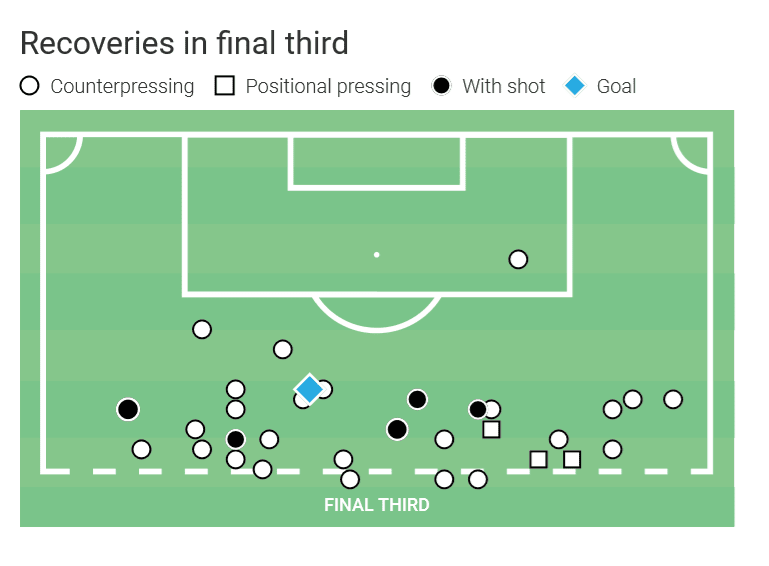
With a high number of Ofoborah’s recoveries being in the final third, the majority coming from counter-pressing. This is a key area to his game, of which he does successfully, winning 65.8% of his 11.36 defensive duels per 90. What’s important to recognise here, is the area in which Ofoborah counter presses. With a high number of recoveries coming in an area that rotating/dropping opposition midfielders are looking to gain possession to progress their side. This is a key concept that Ofoborah looks to implement to stop moves at source, let’s look at some examples.
There are stages to Ofoborah’s pressing as with both positional pressing and counter-pressing in action. The scarce number of positional pressing occurs on the right side, away from Ofoborah’s position within his unit. Whereas his counter-pressing actions occur throughout the final third. This first example shows an example of his counter-pressing, with Ofoborah in the final third. Ofoborah has moved into an advanced role to at first, look to win the second ball (A concept we cover later) and second, to win possession high, preventing any quick transition forwards.
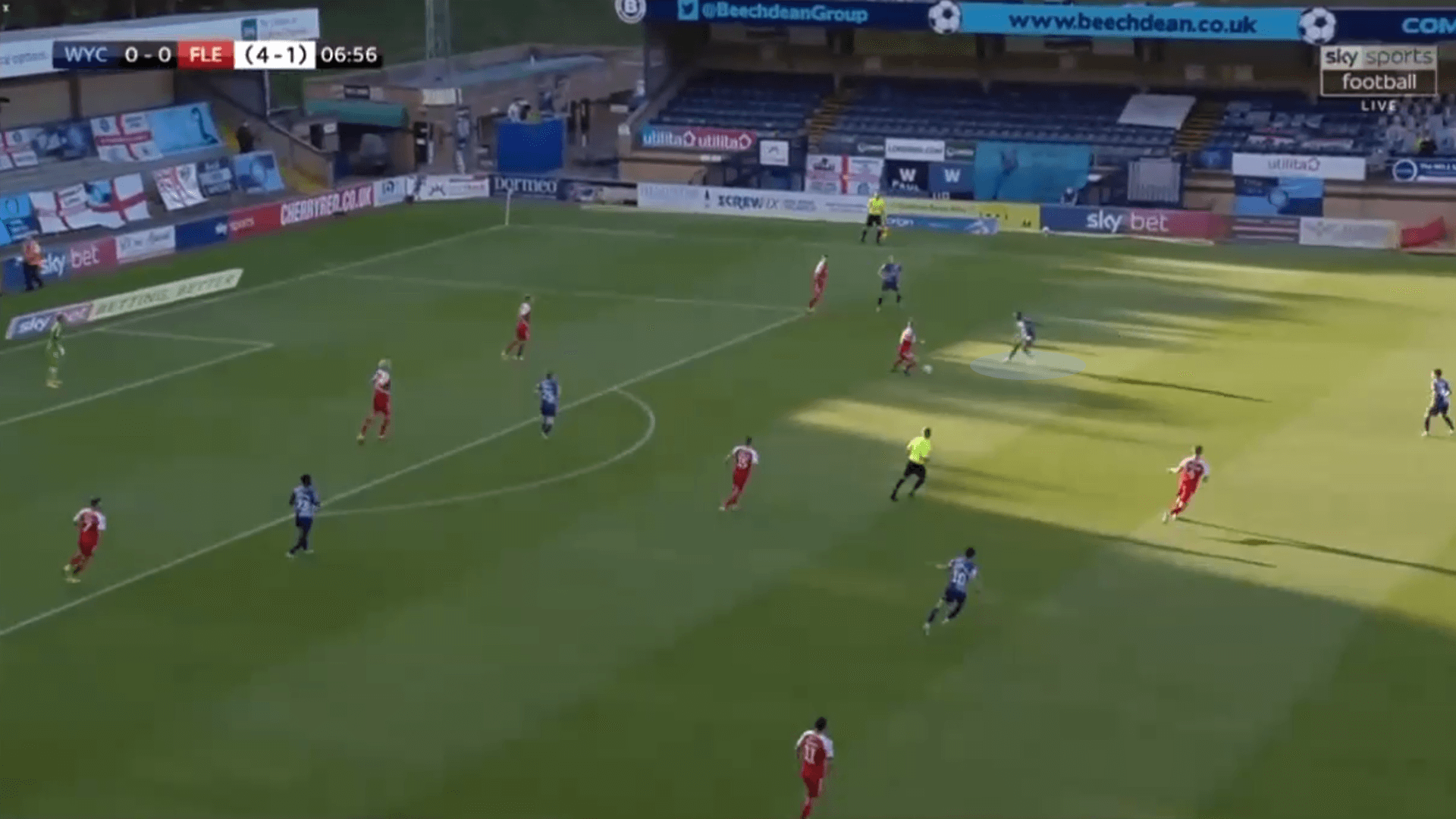
With Ofoborah’s physical ability he has able to position himself early, close to the aerial duel. However, he is also positioned correctly to then counter press the closest opponent to the duel. Applying pressure with intensity, Ofoborah allows his unit to recover behind, finding their closest opponent, reducing the passing opportunity, especially into the wide channel.
Wycombe also has an effective strategy for dealing with any progressions into the wide areas, with Ofoborah a key part. This time with a positional press, as Ofoborah steps out of his units’ line. The example below showcases a key trigger as well for Ofoborah. With Alex Samuel, the forward, cutting off the pitch centrally, the opponent is forced to look into the wide channel. This trigger releases Ofoborah to press and prevent the full-back from playing back away from pressure, reducing the time and space available.
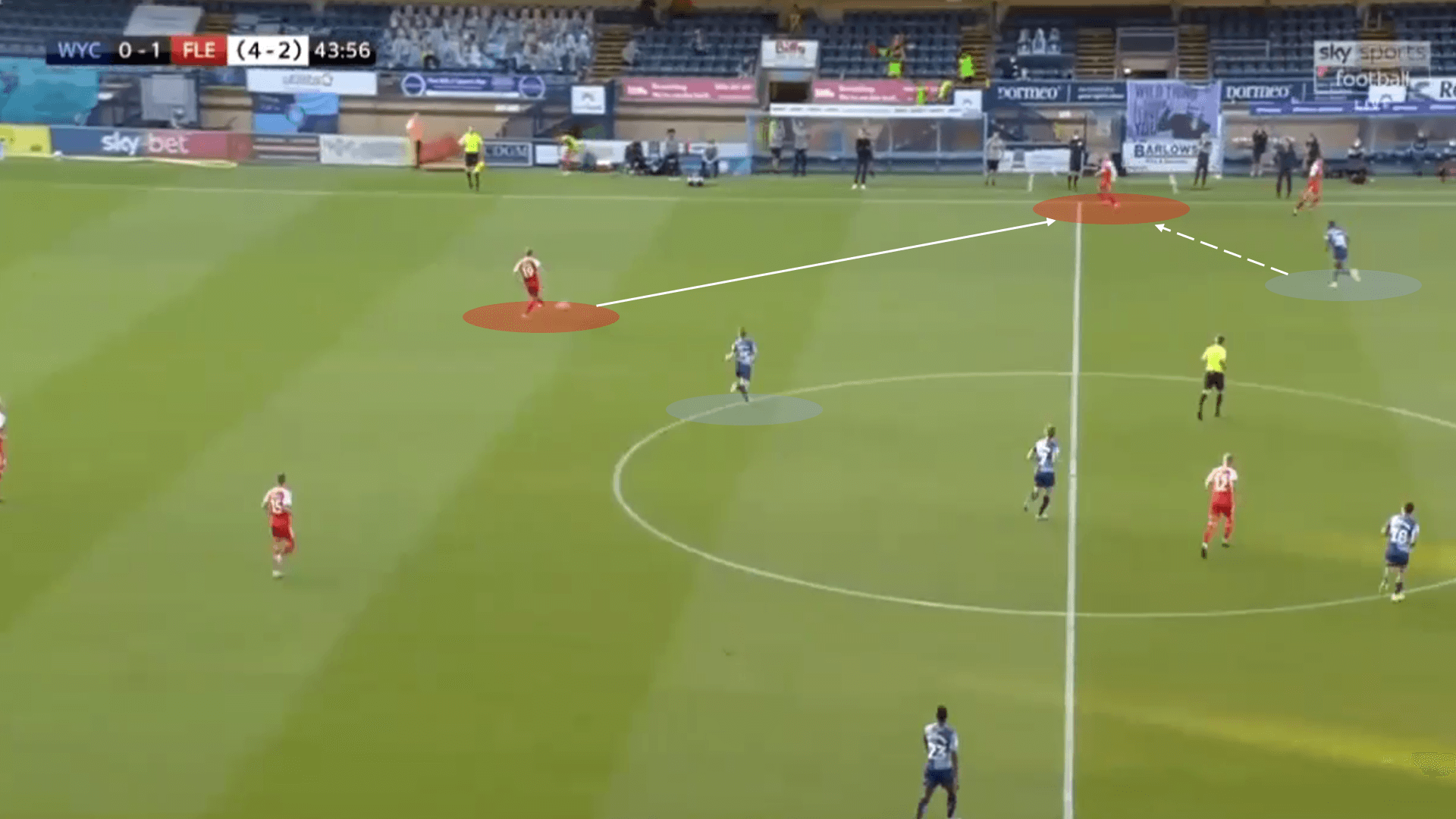
The understanding from Ofoborah to recognise the intensity and angle of the press required allows for Wycombe to create a trap. It also brings his teammates into higher positions, to step onto their nearest opponent.
The final example showcases Ofoborah’s importance to preventing the opponent from progressing, in the middle third. As shown below, Ofoborah recognises the straight pass made into midfield, applying pressure from behind. With Ofoborah’s teammates encouraging a pass centrally, Ofoborah can be aggressive with his press, preventing any turn or chance to play forwards.
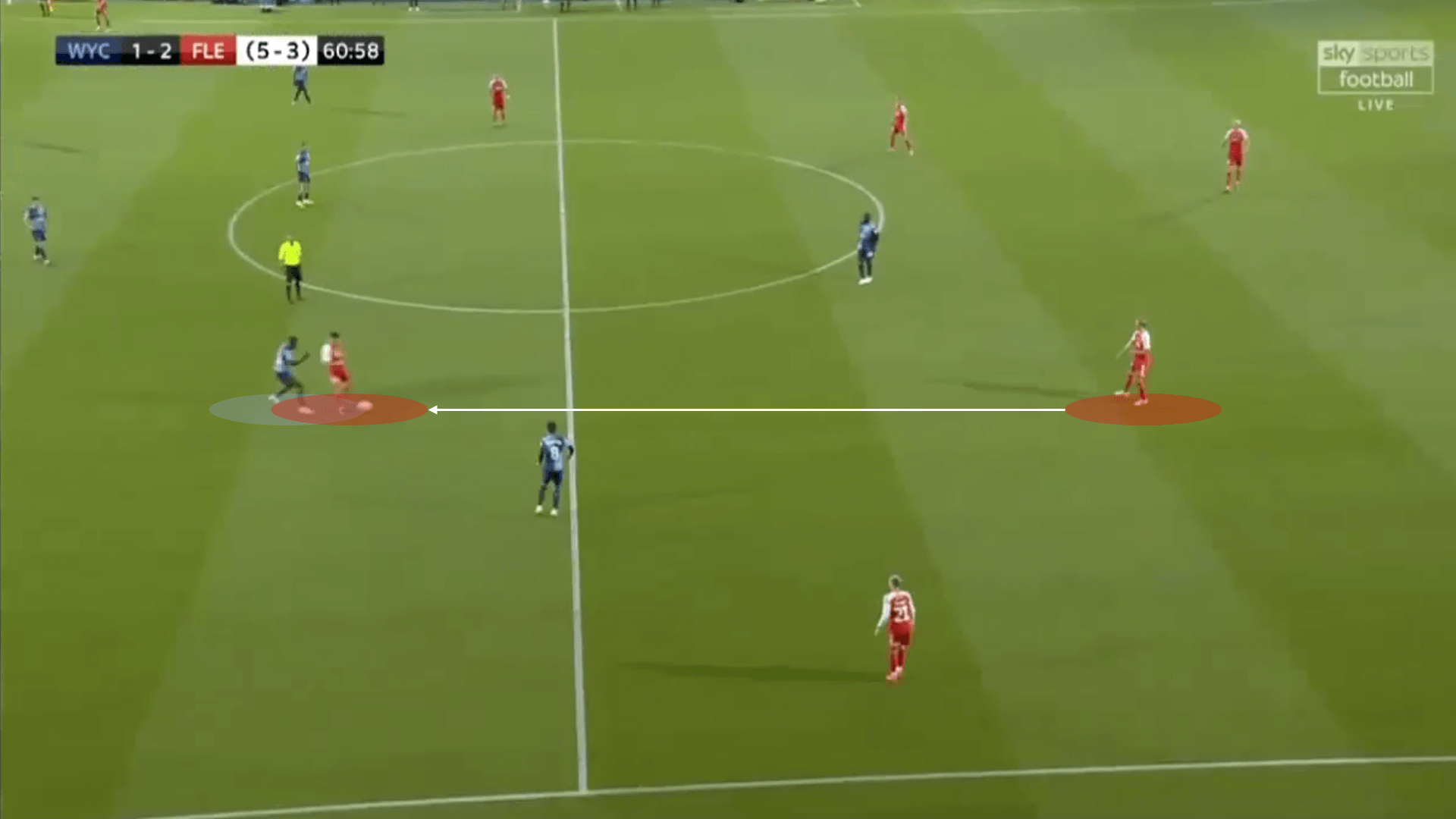
To do this, Ofoborah deaccelerates perfectly, to not allow the opponent to roll or flick around him. He positions his body shape side-on, with his feet apart to give balance, in preparation for any sharp movement. With the physical strength Ofoborah showcases, he encourages his opponent to face away, anticipating an attempted turn, in which case Ofoborah can get his body across to recover possession. Once possession has transitioned, Ofoborah returns to his shape, maintaining balance and cover, until a pressing trigger is present.
Interceptions
Ofoborah clearly plays an important role in the press for Wycombe as shown by his number of interceptions. With 7.25 per 90 and a possession adjusted of 9.67 per 90, Ofoborah displays the intelligence in his positioning to read the game at a high level and break up opponents’ patterns.
The graphic below shows Ofoborah’s recoveries from this season, breaking down into three areas, positioning, counter-pressing and interceptions. As shown, the number of interceptions in the middle third are clear, which is obvious given Ofoborah’s position. What is more important is how centralised these interceptions are. With the vast majority moving into areas where opponents would be looking to find teammates in between lines.
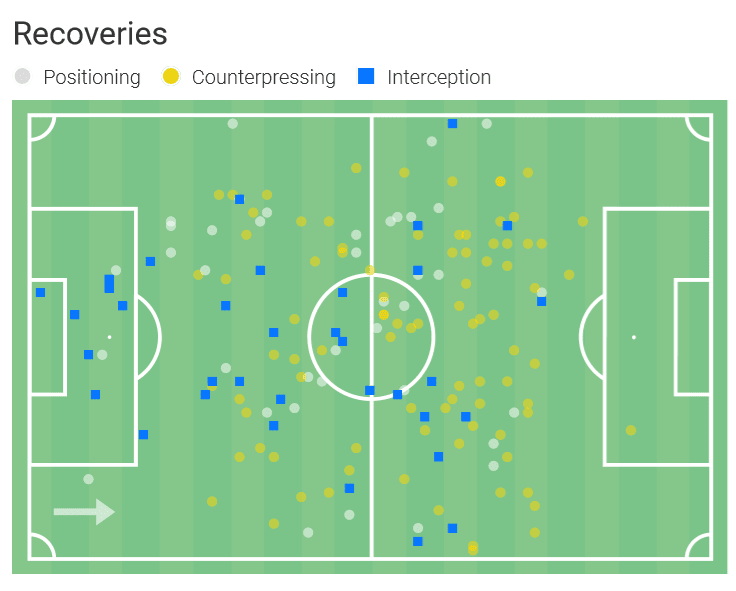
As well as a link to our previous concept, the high number of counter-pressing recoveries made in the attacking third in and around our final concept focusing on winning the second ball.
So let’s take a look at Ofoborah’s interceptions in action. This first example shows a poor progressive pass attempt from the opponent. Ofoborah breaks his defensive line shape, recognising the opportunity to step in to intercept. This is made easier from his start position. By operating slightly deeper, he is able to see man and ball in front to make a judgement decision, while being on the front foot to step in.
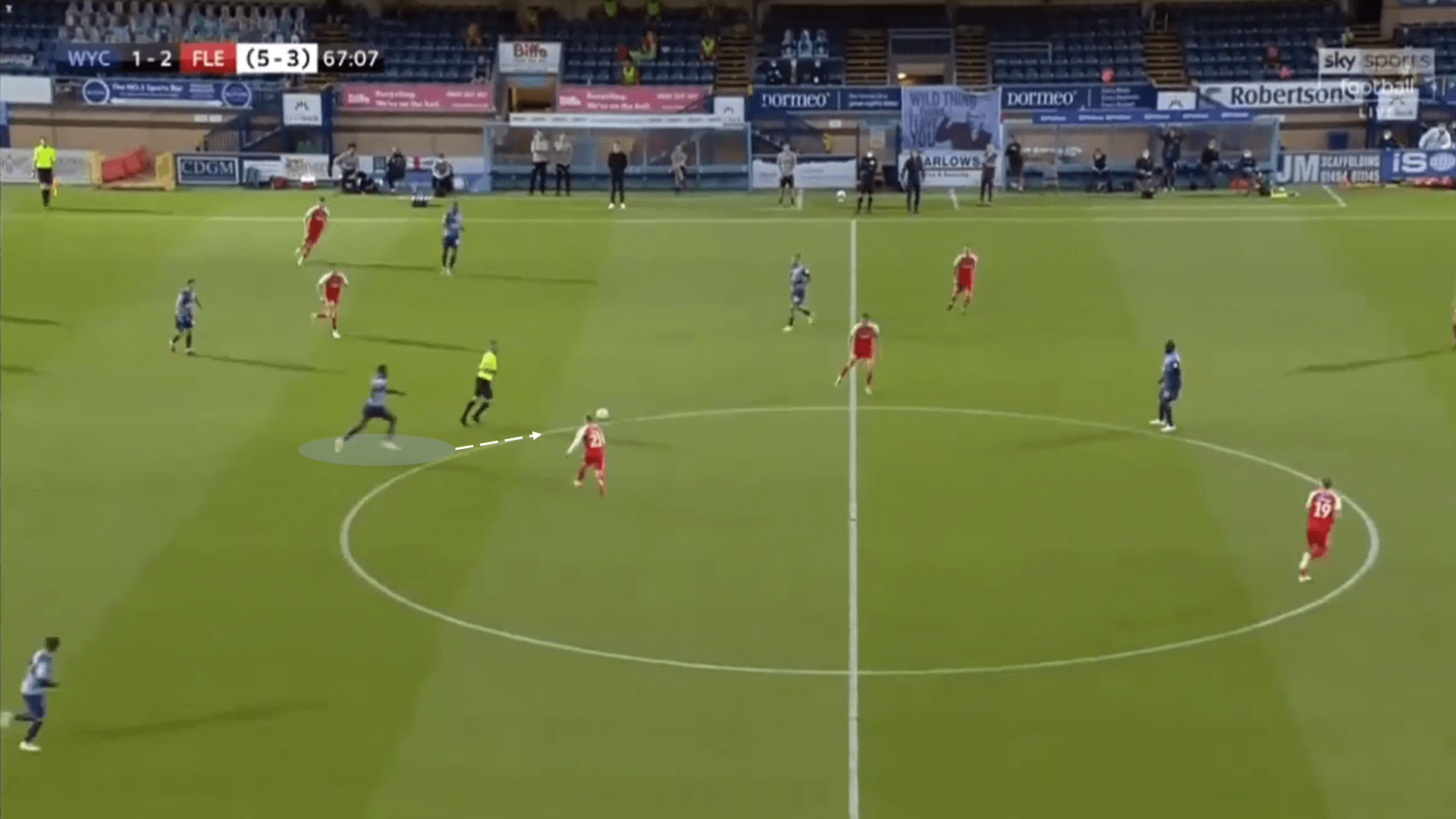
Recognising the poor pass is a key component of Ofoborah’s intercepting role. By being aggressive but controlled, he shows the intelligence to step out of his line, to recover possession before a move can build-up for the opponent. This example is while Wycombe are holding their shape to deflect the opponent, so let’s look at why Wycombe look to win the ball higher.
This next example shows just that. With Wycombe pressing high as shown with the three forward players occupying a similar area, this has forced a rushed, forced pass into the central channel. The high press allows Ofoborah to step higher and occupy a central position to step in and intercept. Wycombe often used a pass into the wide-area as a pressing trigger, as well as occupying those in the wide areas, forcing the opponent inside.
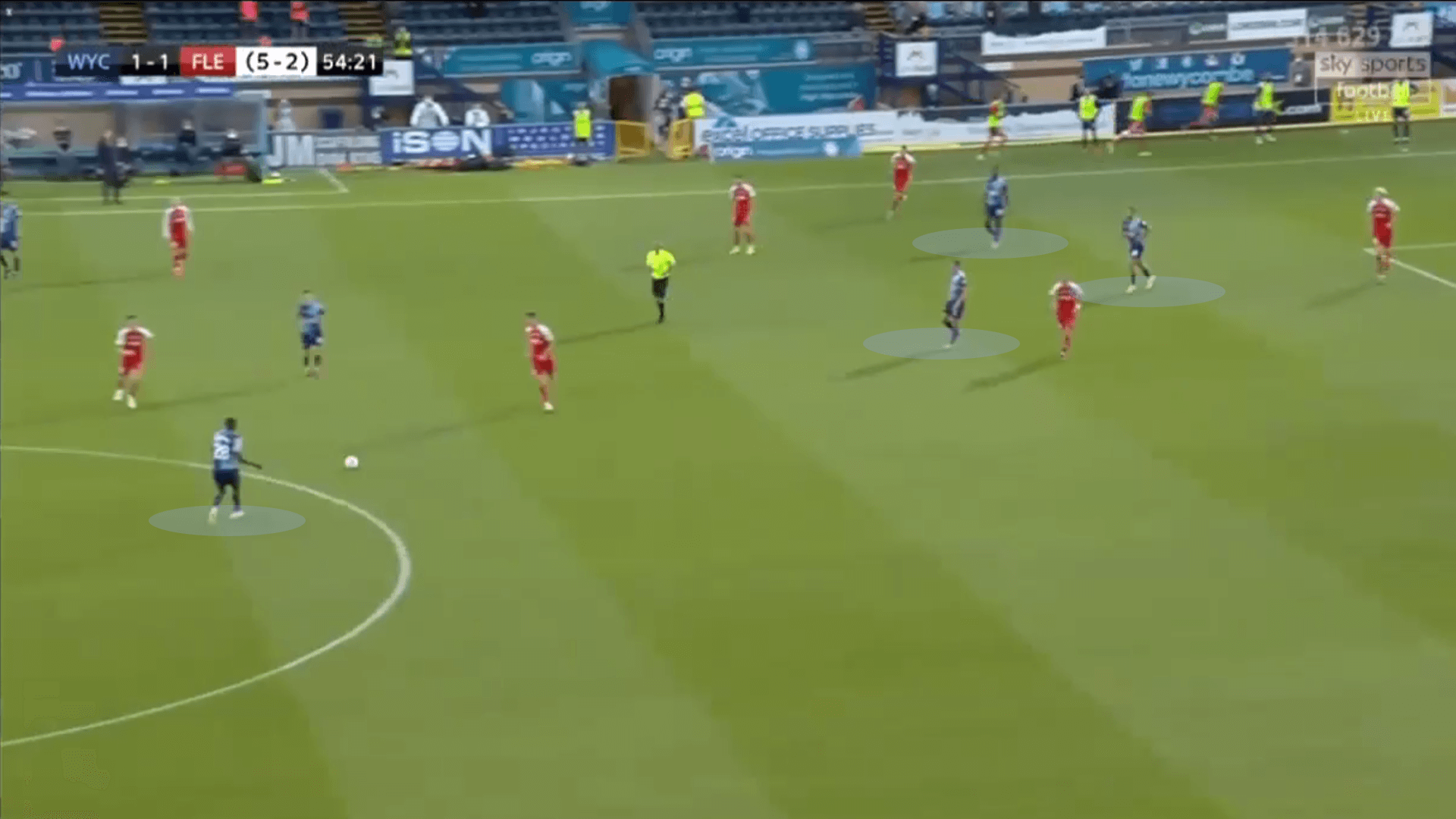
With the press set up, this works straight into Ofoborah’s hands. With the intelligence as mentioned to position himself ready to telegraph any poor progressive pass attempts. Wycombe as a unit work this perfectly, but its Ofoborah who takes the acclaim as shown with his statistics. Without the forward unit, Ofoborah would not be able to get the success he does, but it’s the clever plans Ainsworth has set up that plays into the young midfielder’s strengths.
Second balls
The final aspect of Ofoborah’s game is his positional sense when jumping on the second ball, especially in the opponents third. As part of the aspects mentioned earlier in this analysis, Ofoborah’s role within his sides counter-press leans on his abilities to make a high number of recoveries.
As shown in the example below, Wycombe have targeted a diagonal pass towards the opponents left full-back. Ofoborah positions himself in an around the aerial duel, with the opportunity to jump on either a loose ball. Or close enough to press high on the nearest midfielder for the opponent, with both in front, this gives Ofoborah the chance to react efficiently.

If Ofoborah doesn’t win the second ball, he can apply his pressing principles as mentioned earlier to reduce the opponent to play backwards, as well as encourage teammates to press high man to man. A key aspect in terms of Ofoborah winning the second ball high is to reduce the opportunity for the opponent to play into the wide areas and play around the press. Next, we will look at how Ofoborah applies this in the central third to maintain possession for Wycombe.
As shown in the example below, Ofoborah has jumped on a second ball as part of the aerial duel involving target man Adebayo Akinfenwa. As Akinfenwa comes to meet the ball, Ofoborah moves to a position deeper than the aerial duel to create a 3v3, in between opponents to react in either direction.

Ofoborah reacts quickest to the second ball, on the front foot to drive forwards and look for a pass into the wide channel or play in behind the opponent’s defensive line with space created in behind from Akinfenwa’s movement. In these tight areas, Ofoborah can show his physical power, shoulder to shoulder to maintain possession, providing a platform for his side to build from.
Conclusion
With Ofoborah’s loan finishing at Wycombe, a return would seem a sensible move for the physical midfielder. The qualities he has shown this season alongside the connection with his teammates would make it a popular decision to bring him back as Wycombe take on the mammoth task of the championship.
Questions will be asked of Ofoborah’s technical ability with the step up to a higher level. But with his willingness to work hard and press high when required he is sure to make the step up physically. A young midfielder with plenty of potential, the decision rests on Bournemouth, whether another season out on loan is required before a jump towards the first team.
Certainly, Ofoborah has put his name out there to step up for side when they needed it most to get what would be stated at the start of the season at least, an unlikely promotion.






Comments